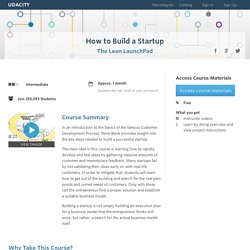

For Entrepreneurs – Google for Entrepreneurs. Some business models. How to build a startup - by Steve Blank. When does the course begin?

This class is self paced. You can begin whenever you like and then follow your own pace. It’s a good idea to set goals for yourself to make sure you stick with the course. How long will the course be available? This class will always be available! How do I know if this course is for me? Take a look at the “Class Summary,” “What Should I Know,” and “What Will I Learn” sections above. Can I skip individual videos? Yes! What are the rules on collaboration? Collaboration is a great way to learn. Why are there so many questions? Udacity classes are a little different from traditional courses.
What should I do while I’m watching the videos? Learn actively! 3 Days Startup. The Anatomy of a YC Pitch. The other night I had an opportunity to attend Demo Day at Y Combinator.

It was a fantastic full frontal assault of entrepreneurial energy. 43 pitches, 2 min each back to back for well over 2 hours. It was clear from the outset that these teams were trained to give a certain kind of pitch with their allotted time. For those who didn’t get the chance to attend, I thought a peek into the anatomy of a Demo Day pitch might be helpful or at least entertaining. So here goes: Slide #1: The elevator pitch. Slide #2: That company or market we just talked about in slide #1? Slide #3: We don’t suck. Slide #4: We’re the team to do it. Slide #5: We’re fast. Slide #6: We’re growing…fast. Given the time constraints, I thought this was a very effective and efficient use of slides.
Given that I haven’t been to a Demo Day in 4 years, I had a few other take aways worth noting: Calling it Demo Day is a bit disingenuous now as no presentations had an actual demo. TheFunded.com: The Resource for Entrepreneurs. How to name your startup. Choosing a name is one of the parts of a startup I find the most difficult.

It’s also something you can easily get hung up on. We all know that the key thing is to move on to actually building something we can put in front of users. Here are 3 steps I would take if I was naming a new startup: 1. If you can, stick to 2 syllables Often constraints are good when undertaking a creative process like naming your startup. GoogleTwitterFacebookFoursquareDropBoxPocketTumblrFlickrHipChatSparrowTweetbotReeder All great startups. SquarePathBox 2. I used to try to be very clever about naming my startup. Unfortunately, I’m not the most creative person. Therefore, since I don’t have that creativity, I take a slightly different approach. I also like the “real word” approach for a couple of other reasons: You’re more likely to end up with a name that can be “spoken” without confusion.
Logo Design, Web Design and More. Design Done Differently. Epipheo Studios. Simple Story Videos - Complex solutions made simple. Easel - Design of web apps. A gallery of startup pitch decks. Startup Compass. Startup Genome. A Deeper Look At Blackbox’s Data On Startup Failure And Its Top Cause: Premature Scaling [Infographic] Earlier this week, we covered Blackbox, the young company responsible for creating The Startup Genome Report, an ongoing, collaborative R&D project designed to take a comprehensive dive into what makes Silicon Valley startups successful — and not.
![A Deeper Look At Blackbox’s Data On Startup Failure And Its Top Cause: Premature Scaling [Infographic]](http://cdn.pearltrees.com/s/pic/th/infographic-techcrunch-15289133)
(Read our initial coverage here.) On Tuesday, we covered the company’s launch of what it calls the Startup Genome Compass, a benchmarking tool for startups that helps founders monitor their progress in different growth categories. Since then, more than 6,000 startups have signed up to use the Compass. Along with the diagnostic tool, Blackbox also released a new research report on the major causes of startup failure, including perhaps more significantly, the primary cause of startups kicking the bucket: Premature scaling.
While this was touched on in our prior coverage, we thought it might be worth elaborating on their findings, including presenting a nifty infographic created by the team over at Visual.ly. Why Startups Fail. Testing business models.